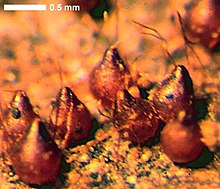Perithecium
Perithecium (plural: Perithecia ) is a term from fungal or lichen science ( mycology and lichenology ).
As perithecia is called pear, ball or bottle-shaped fruiting bodies at Ascomycota (ascomycetes) or lichen . In contrast to the apothecium , the perithecium has no exposed fruit slice. The spores that develop in tubes ( asci ) are usually located between sterile fungal hyphae (paraphyses) and are released through a pore at the apex of the perithecium (or only when it decays). In lichens, perithecia are sunk into the thallus and can only be seen as dark points on the surface.

Traditionally, perithecia-forming fungi are called pyrenomycetes , and apothecia-forming fungi are called discomycetes . This classification has nothing to do with the family relationships. Similarly, the lichens are divided into Pyrenolichenes and Discolichenes , depending on the shape of the fruiting bodies .
literature
- Georg Masuch: Biology of Lichen (= Uni-Taschenbücher 1546). Quelle & Mayer, Heidelberg et al. 1993, ISBN 3-8252-1546-6 .
Individual evidence
- ^ Emil Müller, Wolfgang Loeffler: Mycology. Floor plan for scientists and physicians. 3rd, unchanged edition. Thieme, Stuttgart 1977, ISBN 3-13-436803-X , p. 206.
- ↑ Roland Moberg, Ingmar Holmåsen: Lichen from Northern and Central Europe. An identification book. Fischer, Stuttgart et al. 1992, ISBN 3-437-20471-8 , p. 13 ff.
